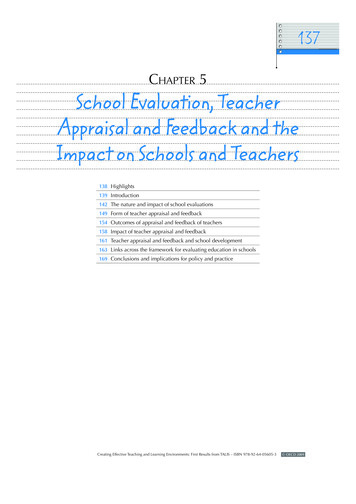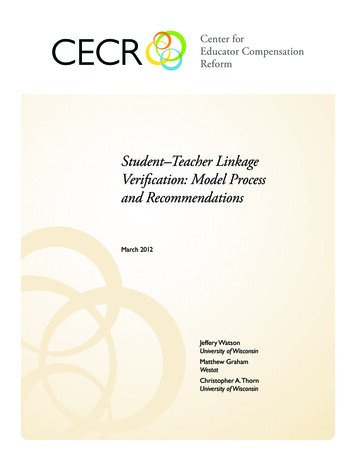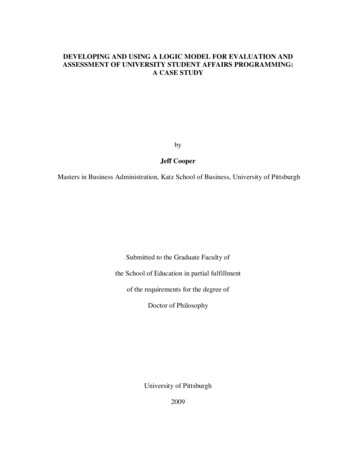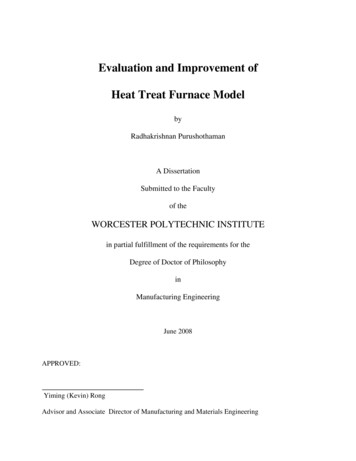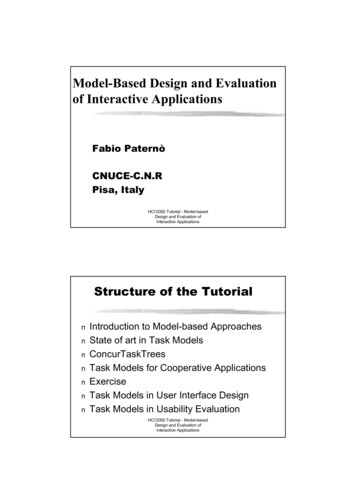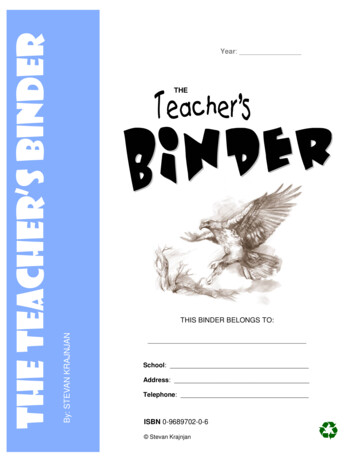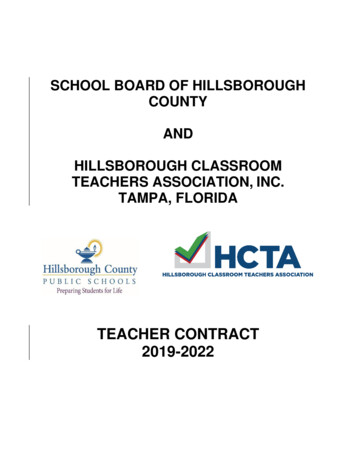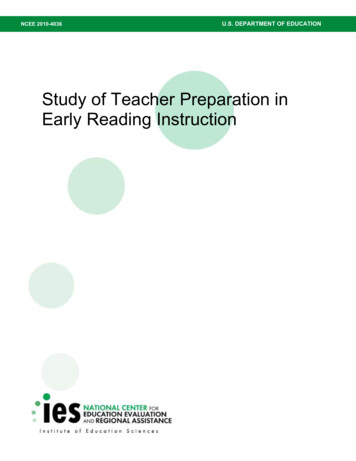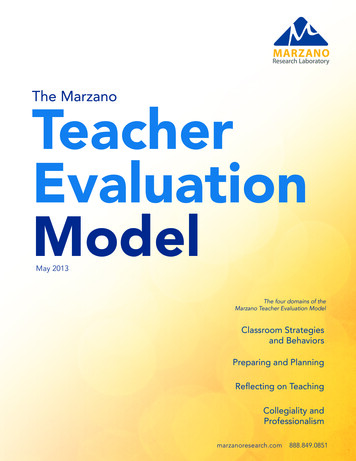
Transcription
The MarzanoTeacherEvaluationModelMay 2013The four domains of theMarzano Teacher Evaluation ModelClassroom Strategiesand BehaviorsPreparing and PlanningReflecting on TeachingCollegiality andProfessionalismmarzanoresearch.com888.849.0851
OUR MISSIONTo provide the best research, themost useful actions, and the highestlevel of services to educators.REPORT AUTHORRobert J. MarzanoBUSINESS DEVELOPMENT OFFICE555 N. Morton StreetBloomington, IN 47404Phone: 888-849-0851Fax: 866-801-1447RESEARCH CENTER9000 E. Nichols Ave. Ste. 112Englewood, CO 80112Phone: 303-766-9199Fax: 303-694-1778www.MarzanoResearch.comOUR VISIONTo continuously develop tools thattranslate high quality educationalresearch into practical applicationseducators can put to immediateuse.OUR GOALTo be the place educators go for thelatest information and data,synthesized into clear, conciseresources that facilitate immediateaction.
Table of ContentsIntroduction .1Elements of the Marzano Teacher Evaluation Model .2Domain 1: Classroom Strategies and Behaviors .2Domain 2: Planning and Preparing .5Domain 3: Reflecting on Teaching .6Domain 4: Collegiality and Professionalism .7The Research Behind the Model .8Experimental/Control Studies .8Correlational Studies .9Technology Studies .9Conclusion .11References .12Appendix: Scales for the Marzano Teacher Evaluation Model .14
IntroductionThe Marzano Teacher Evaluation Model is based on a number of previous, related works,including What Works in Schools (Marzano, 2003), Classroom Instruction That Works(Marzano, Pickering, & Pollock, 2001) Classroom Management That Works (Marzano, 2003),Classroom Assessment and Grading That Work (Marzano, 2006), The Art and Science ofTeaching (Marzano, 2007), and Effective Supervision: Supporting the Art and Science ofTeaching (Marzano, Frontier, & Livingston, 2011). Each of these works was generated from asynthesis of educational research and theory. Thus, the model can be considered an aggregationof the research on those elements that have traditionally been shown to correlate with studentacademic achievement.The model includes four domains:Domain 1: Classroom Strategies and BehaviorsDomain 2: Planning and PreparingDomain 3: Reflecting on TeachingDomain 4: Collegiality and ProfessionalismA variety of states, districts, and schools across the country use the Marzano Teacher EvaluationModel. At a formal level, the states of New York, New Jersey, and Florida employ the model asa whole or in part as the basis for teacher evaluation. It is also being piloted or considered in anumber of other states (e.g., Oklahoma and Missouri). Additionally, a growing number ofdistricts across the country have adopted or adapted the model as the basis for teacher feedbackand development (e.g., Cherry Creek Public Schools, Denver, Colorado; Adams School District50, Westminster, Colorado; and Rockwall School District, Rockwall, Texas). Consultants forMarzano Research Laboratory use the model as the basis for teacher evaluation and feedback inall professional development conducted with individual schools. Thus, the model is also beingused as the basis for professional development in a wide variety of schools across the country.Web-based tools for gathering, aggregating, and reporting data on teacher status and growth areavailable from Learning Science International. 2012 Robert J. Marzano These materials may be used for free in paper form and may only be digitizedin iObservation data system (www.iObservation.com). Schools or districts seeking to digitize these materialsin their own proprietary platform should contact Learning Sciences International.1
Elements of the Marzano Teacher EvaluationModelThe Marzano Teacher Evaluation Model contains sixty elements designed to inform theinstructional practices of teachers. There are forty-one elements in Domain 1, eight in Domain 2,five in Domain 3, and six in Domain 4. The specifics of each domain are outlined below. For adetailed discussion of these elements, see Effective Supervision: Supporting the Art and Scienceof Teaching (Marzano, Frontier, & Livingston, 2011).Domain 1: Classroom Strategies and BehaviorsDomain 1 focuses on classroom strategies and behaviors that impact student achievement. Giventhat forty-one of the sixty elements in the model are from Domain 1, the model clearlyemphasizes what occurs in the classroom, which differentiates it from some other teacherevaluation models. The forty-one elements in Domain 1 are divided into three segments:(1) segments involving routine events, (2) segments addressing content, and (3) segmentsenacted on the spot.Domain 1: Segments Involving Routine EventsDesign Question: What will I do to establish and communicate learning goals, track student progress, andcelebrate success?Element 1: Providing clear learning goals and scales (rubrics)Element 2: Tracking student progressElement 3: Celebrating successDesign Question: What will I do to establish and maintain classroom rules and procedures?Element 4: Establishing and maintaining classroom rules and proceduresElement 5: Organizing the physical layout of the classroom 2012 Robert J. Marzano These materials may be used for free in paper form and may only be digitizedin iObservation data system (www.iObservation.com). Schools or districts seeking to digitize these materialsin their own proprietary platform should contact Learning Sciences International.2
Domain 1: Segments Addressing ContentDesign Question: What will I do to help students effectively interact with new knowledge?Element 6: Identifying critical informationElement 7: Organizing students to interact with new knowledgeElement 8: Previewing new contentElement 9: Chunking content into “digestible bites”Element 10: Helping students process new informationElement 11: Helping students elaborate on new informationElement 12: Helping students record and represent knowledgeElement 13: Helping students reflect on their learningDesign Question: What will I do to help students practice and deepen their understanding of newknowledge?Element 14: Reviewing contentElement 15: Organizing students to practice and deepen knowledgeElement 16: Using homeworkElement 17: Helping students examine similarities and differencesElement 18: Helping students examine errors in reasoningElement 19: Helping students practice skills, strategies, and processesElement 20: Helping students revise knowledgeDesign Question: What will I do to help students generate and test hypotheses about new knowledge?Element 21: Organizing students for cognitively complex tasksElement 22: Engaging students in cognitively complex tasks involving hypothesis generation and testingElement 23: Providing resources and guidance 2012 Robert J. Marzano These materials may be used for free in paper form and may only be digitizedin iObservation data system (www.iObservation.com). Schools or districts seeking to digitize these materialsin their own proprietary platform should contact Learning Sciences International.3
Domain 1: Segments Enacted on the SpotDesign Question: What will I do to engage students?Element 24: Noticing when students are not engagedElement 25: Using academic gamesElement 26: Managing response ratesElement 27: Using physical movementElement 28: Maintaining a lively paceElement 29: Demonstrating intensity and enthusiasmElement 30: Using friendly controversyElement 31: Providing opportunities for students to talk about themselvesElement 32: Presenting unusual or intriguing informationDesign Question: What will I do to recognize and acknowledge adherence or lack of adherence to rules andprocedures?Element 33: Demonstrating “withitness”Element 34: Applying consequences for lack of adherence to rules and proceduresElement 35: Acknowledging adherence to rules and proceduresDesign Question: What will I do to establish and maintain effective relationships with students?Element 36: Understanding students’ interests and backgroundsElement 37: Using verbal and nonverbal behaviors that indicate affection for studentsElement 38: Displaying objectivity and controlDesign Question: What will I do to communicate high expectations for all students?Element 39: Demonstrating value and respect for low-expectancy studentsElement 40: Asking questions of low-expectancy studentsElement 41: Probing incorrect answers with low-expectancy students 2012 Robert J. Marzano These materials may be used for free in paper form and may only be digitizedin iObservation data system (www.iObservation.com). Schools or districts seeking to digitize these materialsin their own proprietary platform should contact Learning Sciences International.4
Domain 2: Planning and PreparingDomain 2 focuses on planning and preparing, both of which are assumed to be directly linked toclassroom strategies and behaviors. Careful planning and preparation gives a teacher enoughtime to incorporate effective classroom strategies and behaviors. The eight elements in Domain 2are divided into three categories: (1) planning and preparing for lessons and units, (2) planningand preparing for use of materials and technology, and (3) planning and preparing for specialneeds of students.Domain 2: Planning and Preparing for Lessons and UnitsElement 1: Planning and preparing for effective scaffolding of information within lessonsElement 2: Planning and preparing for lessons within a unit that progress toward a deep understandingand transfer of contentElement 3: Planning and preparing for appropriate attention to established content standardsDomain 2: Planning and Preparing for Use of Materials and TechnologyElement 4: Planning and preparing for the use of available materials for upcoming units and lessonsElement 5: Planning and preparing for the use of available technologies such as interactive whiteboards,response systems, and computersDomain 2: Planning and Preparing for Special Needs of StudentsElement 6: Planning and preparing for the needs of English language learnersElement 7: Planning and preparing for the needs of special education studentsElement 8: Planning and preparing for the needs of students who come from home environments thatoffer little support for schooling 2012 Robert J. Marzano These materials may be used for free in paper form and may only be digitizedin iObservation data system (www.iObservation.com). Schools or districts seeking to digitize these materialsin their own proprietary platform should contact Learning Sciences International.5
Domain 3: Reflecting on TeachingDomain 3 focuses on teacher self-reflection, a vital metacognitive step in teacher development.The five elements in Domain 3 are divided into two categories: (1) evaluating personalperformance and (2) developing and implementing a professional growth plan.Domain 3: Evaluating Personal PerformanceElement 1: Identifying specific areas of pedagogical strength and weakness within Domain 1Element 2: Evaluating the effectiveness of individual lessons and unitsElement 3: Evaluating the effectiveness of specific pedagogical strategies and behaviors across differentcategories of studentsDomain 3: Developing and Implementing a ProfessionalGrowth and Development PlanElement 4: Developing a written growth and development planElement 5: Monitoring progress relative to the professional growth and development plan 2012 Robert J. Marzano These materials may be used for free in paper form and may only be digitizedin iObservation data system (www.iObservation.com). Schools or districts seeking to digitize these materialsin their own proprietary platform should contact Learning Sciences International.6
Domain 4: Collegiality and ProfessionalismDomain 4 focuses on teacher collegiality and professional behavior. These behaviors are onlyindirectly linked to classroom strategies and behaviors; however, they make up the foundationalexpertise from which the preceding three domains can flourish. The six elements in Domain 4are divided into three categories: (1) promoting a positive environment, (2) promoting exchangeof ideas and strategies, and (3) promoting district and school development.Domain 4: Promoting a Positive EnvironmentElement 1: Promoting positive interactions about colleaguesElement 2: Promoting positive interactions about students and parentsDomain 4: Promoting Exchange of Ideas and StrategiesElement 3: Seeking mentorship for areas of need or interestElement 4: Mentoring other teachers and sharing ideas and strategiesDomain 4: Promoting District and School DevelopmentElement 5: Adhering to district and school rules and proceduresElement 6: Participating in district and school initiativesAs indicated above, Domain 1 contains forty-one elements, Domain 2 contains eight elements,Domain 3 contains five elements, and Domain 4 contains six elements. Teacher status andgrowth can be assessed in each component of the model in a manner that is consistent with stateguidelines and the requirements of Race to the Top legislation. 2012 Robert J. Marzano These materials may be used for free in paper form and may only be digitizedin iObservation data system (www.iObservation.com). Schools or districts seeking to digitize these materialsin their own proprietary platform should contact Learning Sciences International.7
The Research Behind the ModelEach of the works from which the model was developed report substantial research on theelements they address. For example, The Art and Science of Teaching includes over 25 tablesreporting the research on the various elements of Domain 1. These tables report the findingsfrom meta-analytic studies and the average effect sizes computed in these studies. In all, over5,000 studies (i.e., effect sizes) are covered in the tables representing research over the last fivedecades. The same can be said for the other titles listed above. Thus, one can say that the modelwas initially based on thousands of studies that span multiple decades and these studies werechronicled and catalogued in books that have been widely disseminated in the United States.Specifically, over 2 million copies of the books cited above have been purchased anddisseminated to K–12 educators across the United States.Experimental/Control StudiesPerhaps one of the more unique aspects of the research on this model is that a growing number ofexperimental/control studies have been conducted by practicing teachers on the effectiveness ofspecific strategies in their classrooms (see Haystead & Marzano, 2010b). This is unusual in thesense that these studies are designed to establish a direct causal link between elements of themodel and student achievement. Studies that use correlation analysis techniques (see nextsection) can establish a link between elements of a model and student achievement, but causalitycannot be easily inferred. Other evaluation models currently used throughout the country appearto rely more heavily or exclusively on correlational data regarding the relationship between theirelements and student achievement.To date, over 300 experimental/control studies have been conducted. These studies involved over14,000 students and 300 teachers across 38 schools in 14 districts. The average effect size forstrategies addressed in the studies was .42, with some studies reporting effect sizes of 2.00 andhigher. An average effect size of .42 is associated with a 16 percentile point gain in studentachievement. Stated differently, on average when teachers use the classroom strategies and 2012 Robert J. Marzano These materials may be used for free in paper form and may only be digitizedin iObservation data system (www.iObservation.com). Schools or districts seeking to digitize these materialsin their own proprietary platform should contact Learning Sciences International.8
behaviors in the model, their typical student achievement increased by 16 percentile points.However, even larger gains (e.g., those associated with effect sizes as high as 2.00) can berealized if specific strategies are used in specific ways.Correlational StudiesAs mentioned above, correlational studies are the most common approach to examining thevalidity of an evaluation model. Such studies have been and continue to be conducted on variouselements of the Marzano Teacher Evaluation Model. For example, such a study was conducted inthe state of Oklahoma as a part of their examination of elements related to student achievementin K–12 schools (see What Works in Oklahoma Schools: Phase I Report and What Works inOklahoma Schools: Phase II Report by Marzano Research Laboratory, 2010 and 2011,respectively). These studies involved 59 schools, 1,117 teachers, and over 13,000 K–12 students.Collectively, the reports indicate positive relationships with various elements of the MarzanoTeacher Evaluation Model across the domains. Specific emphasis was placed on Domain 1,particularly in the Phase II report. Using state mathematics and reading test data, 96% of the 82correlations (i.e., 41 correlations for mathematics and 41 for reading) were found to be positive,with some as high as .40 and greater. A .40 correlation translates to an effect size (i.e.,standardized mean difference) of .87 which is associated with a 31 percentile point gain instudent achievement. These studies also aggregated data across the nine design questions inDomain 1. All correlations were positive for this aggregated data. Seven of those correlationsranged from .33 to .40. These correlations translate into effect sizes of .70 and higher. Relativelylarge correlations such as these were also reported for the total number of Domain 1 strategiesused by teachers in a school, implying a schoolwide effect for the use of the model. Specifically,the number of Domain 1 strategies teachers used in school had a .35 correlation with readingproficiency and a .26 correlation with mathematics proficiency.Technology StudiesAnother unique aspect of the research conducted on the model is that its effects have beenexamined in the context of technology. For example, a two-year study was conducted todetermine (in part) the relationship between selected elements from Domain 1 and the 2012 Robert J. Marzano These materials may be used for free in paper form and may only be digitizedin iObservation data system (www.iObservation.com). Schools or districts seeking to digitize these materialsin their own proprietary platform should contact Learning Sciences International.9
effectiveness of interactive whiteboards in enhancing student achievement (see Final Report: ASecond Year Evaluation Study of Promethean ActivClassroom by Haystead & Marzano, 2010a).In all, 131 experimental/control studies were conducted across various grade levels. Selectedelements of Domain 1 were correlated with the effect sizes for use of the interactive whiteboards.All correlations for Domain 1 elements were positive, with some as high as .70. This implies thatthe effectiveness of interactive whiteboards as used in these 131 studies was greatly enhanced bythe use of Domain 1 strategies. 2012 Robert J. Marzano These materials may be used for free in paper form and may only be digitizedin iObservation data system (www.iObservation.com). Schools or districts seeking to digitize these materialsin their own proprietary platform should contact Learning Sciences International.10
ConclusionIn summary, the Marzano Teacher Evaluation Model was designed using thousands of studiesconducted over the past five or more decades, and published in books that have been widely usedby K–12 educators. In addition, experimental/control studies have been conducted that establishmore direct causal linkages with enhanced student achievement than can be made with othertypes of data analysis. Correlation studies (the more typical approach to examining the viabilityof a model) have also been conducted, indicating positive correlations between the elements ofthe model and student mathematics and reading achievement. Finally, the model has beenstudied as to its effects on the use of technology (i.e., interactive whiteboards), and found to behighly correlated with the effectiveness of that technology. 2012 Robert J. Marzano These materials may be used for free in paper form and may only be digitizedin iObservation data system (www.iObservation.com). Schools or districts seeking to digitize these materialsin their own proprietary platform should contact Learning Sciences International.11
ReferencesHaystead, M. W., & Marzano, R. J. (2010a). Final report: A second year evaluation study ofPromethean ActivClassroom. Englewood, CO: Marzano Research Laboratory(marzanoresearch.com).Haystead, M. W., & Marzano, R. J. (2010b). Meta-analytic synthesis of studies conducted atMarzano Research Laboratory on instructional strategies. Englewood, CO: MarzanoResearch Laboratory (marzanoresearch.com).Marzano, R. J. (with Marzano, J. S., & Pickering, D. J.). (2003). Classroom management thatworks: Research-based strategies for every teacher. Alexandria, VA: Association forSupervision and Curriculum Development.Marzano, R. J. (2003). What works in schools: Translating research into action. Alexandria,VA: Association for Supervision and Curriculum Development.Marzano, R. J. (2006). Classroom assessment and grading that work. Alexandria, VA:Association for Supervision and Curriculum Development.Marzano, R. J. (2007). The art and science of teaching: A comprehensive framework for effectiveinstruction. Alexandria, VA: Association for Supervision and Curriculum Development.Marzano, R. J., Frontier, T., & Livingston, D. (2011). Effective supervision: Supporting the artand science of teaching. Alexandria VA: Association for Supervision and CurriculumDevelopment. 2012 Robert J. Marzano These materials may be used for free in paper form and may only be digitizedin iObservation data system (www.iObservation.com). Schools or districts seeking to digitize these materialsin their own proprietary platform should contact Learning Sciences International.12
Marzano, R. J., Pickering, D. J., & Pollock, J. E. (2001). Classroom instruction that works:Research-based strategies for increasing student achievement. Alexandria, VA:Association for Supervision and Curriculum Development.Marzano Research Laboratory. (2010). What works in Oklahoma schools: Phase I report.Englewood, CO: Author (marzanoresearch.com).Marzano Research Laboratory. (2011). What works in Oklahoma schools: Phase II report.Englewood, CO: Author (marzanoresearch.com). 2012 Robert J. Marzano These materials may be used for free in paper form and may only be digitizedin iObservation data system (www.iObservation.com). Schools or districts seeking to digitize these materialsin their own proprietary platform should contact Learning Sciences International.13
AppendixScales for the Marzano Teacher EvaluationModel 2012 Robert J. Marzano These materials may be used for free in paper form and may only be digitizedin iObservation data system (www.iObservation.com). Schools or districts seeking to digitize these materialsin their own proprietary platform should contact Learning Sciences International.14
DOMAIN 1: CLASSROOM STRATEGIES AND BEHAVIORSLesson Segments Involving Routine EventsDesign Question: What will I do to establish and communicatelearning goals, track student progress, and celebrate success?Element 1: Providing Clear Learning Goals and Scales (Rubrics)The teacher provides a clearly stated learning goal accompanied by scale or rubric that describes levels ofperformance relative to the learning goal.Teacher EvidenceStudent Evidence Teacher has a learning goal posted so allstudents can see it. When asked, students can explain the learninggoal for the lesson. The learning goal is a clear statement ofknowledge or information as opposed to an activityor assignment. When asked, students can explain how theircurrent activities relate to the learning goal. Teacher makes reference to the learning goalthroughout the lesson. When asked, students can explain the meaningof the levels of performance articulated in the scaleor rubric. Teacher has a scale or rubric that relates to thelearning goal posted so that all students can see it. Teacher makes reference to the scale or rubricthroughout the lesson.ScaleInnovating (4)Applying (3)Developing (2)Adapts and createsnew strategies forunique studentneeds andsituationsProvides a clearlystated learninggoal accompaniedby a scale or rubricthat describeslevels ofperformance andmonitors students’understanding ofthe learning goaland the levels ofperformanceProvides a clearlystated learninggoal accompaniedby a scale or rubricthat describeslevels ofperformanceBeginning (1)Not Using (0)Uses strategyincorrectly or withparts missingStrategy wascalled for but notexhibited 2012 Robert J. Marzano These materials may be used for free in paper form and may only be digitizedin iObservation data system (www.iObservation.com). Schools or districts seeking to digitize these materialsin their own proprietary platform should contact Learning Sciences International.15
DOMAIN 1: CLASSROOM STRATEGIES AND BEHAVIORSLesson Segments Involving Routine EventsElement 2: Tracking Student ProgressThe teacher facilitates tracking of student progress on one or more learning goals using a formativeapproach to assessment.Teacher EvidenceStudent Evidence Teacher helps students track their individualprogress on the learning goal. When asked, students can describe their statusrelative to the learning goal using the scale or rubric. Teacher assigns scores using a scale or rubricthat depicts student status relative to the learninggoal. Students systematically update their status onthe learning goal. Teacher uses formal and informal means toassign scores to students. Teacher charts the progress of the entire classon the learning goal.ScaleInnovating (4)Applying (3)Adapts and createsnew strategies forunique studentneeds andsituationsFacilitates trackingof student progressusing a formativeapproach toassessment andmonitors the extentto which studentsunderstand theirlevel ofperformanceDeveloping (2)Beginning (1)Not Using (0)Facilitates tracking Uses strategyof student progress incorrectly or withusing a formativeparts missingapproach toassessmentStrategy wascalled for but notexhibited 2012 Robert J. Marzano These materials may be used for free in paper form and may only be digitizedin iObservation data system (www.iObservation.com). Schools or districts seeking to digitize these materialsin their own proprietary platform should contact Learning Sciences International.16
DOMAIN 1: CLASSROOM STRATEGIES AND BEHAVIORSLesson Segments Involving Routine EventsElement 3: Celebrating SuccessThe teacher provides students with recognition of their current status and their knowledge gain relative tothe learning goal.Teacher EvidenceStudent Evidence Teacher acknowledges students who haveachieved a certain score on the scale or rubric. Students show signs of pride regarding theiraccomplishments in the class. Teacher acknowledges students who have madegains in their knowledge and skill relative to thelearning goal. When asked, students say they want to continueto make progress. Teacher acknowledges and celebrates the finalstatus and progress of the entire class. Teacher uses a variety of ways to celebratesuccess, such as (1) show of hands, (2) certificationof success, (3) parent notification, and (4) round ofapplause.ScaleInnovating (4)Applying (3)Developing (2)Adapts and createsnew strategies forunique studentneeds andsituationsProvides studentswith recognition oftheir current statusand theirknowledge gainrelative to thelearning goal andmonitors the extentto which studentsare motivated toenhance theirstatusProvides studentswith recognition oftheir current statusand theirknowledge gainrelative to thelearning goalBeginning (1)Not Using (0)Uses strategyincorrectly or withparts missingStrategy wascalled for but notexhibited 2012 Robert J. Marzano These materials may be used for free in paper form and may only be digitizedin iObservation data system (www.iObservation.com). Schools or districts seeking to digitize these materialsin their own proprietary platform should contact Learning Sciences International.17
DOMAIN 1: CLASSROOM STRATEGIES AND BEHAVIORSLesson Segments Involving Routine EventsDesign Question: What will I do to establish and maintain classroomrules and procedures?Element 4: Establishing and Maintaining Classroom Rules and ProceduresThe teacher reviews expectations regarding rules and procedures to ensure their effective execution.Teacher EvidenceStudent Evidence Teacher involves students in designingclassroom routines. Stud
Domain 1: Classroom Strategies and Behaviors Domain 1 focuses on classroom strategies and behaviors that impact student achievement. Given that forty-one of the sixty elements in the model are from Domain 1, the model clearly emphasizes what occurs in the classroom, which dif
